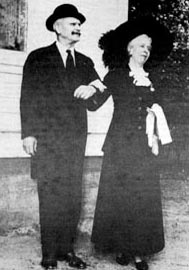A Homestead Frat House
A Homestead Frat House
This article appeared in the fall 1982 issue of Alaska Alumnus. By Arthur W. Loftus
Arthur Loftus was one of the first six students to register at the Alaska Agricultural College and School of Mines. His wife, Dorothy Roth Loftus, was also among the first half-dozen students. The Loftus family has a road named after them near the UAF campus.

Land has ever been a godsend to American free education. Western schools in particular have profitted from land grants in a way scarcely to be realized in the older, settled communities. Standing at the breast of the wilderness, the early colleges of the State had peculiar advantages, garnering from the experiences of the East, gaining vigor and self-reliance from a new and untried domain. But this, the last of the land grant colleges, has a unique feature. Several students have taken homesteads joining the campus, have built their own cabins, hunted their own game, and have lived a jolly "frat-house" life, without the bother of Greek letters on the door or the nuisance of house rules.

My brothers, Jule and Theodore, and I, found that we could each take a homestead adjoining
the campus. After staking our claims, we skidded together a lot of fine logs last
spring, and then the building operations rested until late in the fall. Jule chose
a rather enchanting spot for our cabin beside the Jennie M. slough, among tall spruces
and cottonwoods, in the broad valley that presents such a fine view from the College
hill. The cellar was dug in the spring, as fast as the ground thawed down, and the
dirt was used as a raised foundation for the structure.
The October sun had already begun to hang low over the southern range before we had
erected our four solid walls, six feet high, twenty feet wide, and twenty-two feet
long. By placing strips of moss on top of each layer of logs the question of chinking
was settled in an easy manner. The logs were quite heavy, some weighing over a thousand
pounds, but the three of us lusty brothers, by lifting one end at a time, managed
to get them in place.
We made a gable roof of split logs and loaded them with moss and sand. The roof purlines
are fully thirty feet long, and extend out from the front of the cabin eight feet
for a tentative porch. We used three together in the gable.
Altogether it is warm and substantial. We propose to make it our "frat house" throughout
our college careers.
Now, instead of taking the gas-electric inter-urban to Fairbanks, after a day at school, we brothers file down the hill, past the College station, along the track for a distance, and through the spruce by a trail we blazed ourselves, to the little clearing where is the cozy cabin we call home.

Indeed, it seems good, after a strenuous day of wrestling with the college work, to
come out into this wilderness setting, so picturesque against the remote background
of the autumn sun shining through the tall spruce, as it slowly drops behind the Alaska
Range. It is uncommonly pleasant, we find, in the dark winter days to follow the narrow
path overhung with the peaceful, snow-laden trees, and to emerge at last upon a primitive
clearing that is all the result of our own labor, and that might from its appearance,
be a thousand miles from college or from civilization.
Carrying as we three do, the memory of Wisconsin's forests and of her sturdy axe-swingers,
it is with a feeling of home-like satisfaction that we approach the solid walls of
the cabin, with the woolly moss bulging out from between logs teen to sixteen inches
in diameter. There are the heavy, peeled poles which support the roof, and from them
hangs the goodly supply of meat which is frozen all winter.
Stepping through the double door, one gets an impression of homeliness and comfort
from the inside of the cabin, which is well lighted by a gasoline lamp. Three homemade
single beds are arranged against the walls. Ted's, being on the davenport style and
more attractive, is considerately called the "deacon seat." The stove is in one corner,
and the table is in the center of the room.
We get clear, soft water from the slough beside the cabin, and for firewood we have
only to fall a tree across the doorstep, cut it up, and carry it in. Big, far, white
rabbits are innumerable about the place, and spruce hens and grouse are plentiful
near-by. Jule and Ted spent the Thanksgiving and Christmas holidays hunting on the
Healy River, and along the Valdez Trail, and, as a result, we have had a varied supply
of meat all winter, without ever buying a pound: prime mountain sheep, caribou and
moose. I am convinced that at no other college in the world can a student secure a
long winter's supply of excellent meat, from a short, pleasant hunt, as easily and
certainly as he can in the Fairbanks district. Here is where pleasure and profit really
go hand in hand.
What more would a student want than to take a homestead beside the campus for one
verse of a song, and live within a few minutes' walk of a first-class mining college,
in a district where what one learns from books about geology, prospecting and mining,
can be practiced in slightly explored territory? Here are the advantages of civilization,
combined with the lure of the wilderness. When the restless youth of the States realize
that they can attend a real mining college, whose professors are not mere theorists
but are alive to the possibilities of mining in Alaska, in the very heart of the gold
country, it may be a good many more will follow the trail North.
